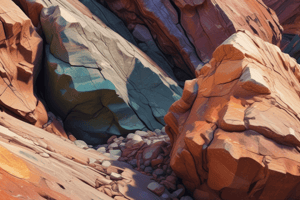Podcast
Questions and Answers
What is metamorphism?
What is metamorphism?
The process where one type of rock changes into metamorphic rock because of chemical processes or changes in temperature and pressure.
Where does metamorphic rock form?
Where does metamorphic rock form?
Deep within the earth's crust.
What three types of rock can metamorphic rock form from?
What three types of rock can metamorphic rock form from?
Igneous, sedimentary, or metamorphic.
What causes some minerals to change into other minerals during metamorphism?
What causes some minerals to change into other minerals during metamorphism?
What gives metamorphic rock a layered appearance?
What gives metamorphic rock a layered appearance?
The type of rock that forms because of ___ can indicate the conditions that were in place when the original rock changed.
The type of rock that forms because of ___ can indicate the conditions that were in place when the original rock changed.
When does metamorphism occur?
When does metamorphism occur?
What is contact metamorphism?
What is contact metamorphism?
Describe the area of the rock that is affected by contact metamorphism.
Describe the area of the rock that is affected by contact metamorphism.
What is regional metamorphism?
What is regional metamorphism?
Metamorphic rocks are usually __________ and strong.
Metamorphic rocks are usually __________ and strong.
Which type of metamorphism causes most metamorphic rock to form?
Which type of metamorphism causes most metamorphic rock to form?
Why are rocks that formed as a result of contact metamorphism often found near those formed by regional metamorphism?
Why are rocks that formed as a result of contact metamorphism often found near those formed by regional metamorphism?
How are metamorphic rocks classified?
How are metamorphic rocks classified?
What is a parent rock?
What is a parent rock?
What is a daughter rock?
What is a daughter rock?
Which type of rock is described as the softest and can crumble relatively easily?
Which type of rock is described as the softest and can crumble relatively easily?
Which type of rock is known to be hard but can form sediments by weathering?
Which type of rock is known to be hard but can form sediments by weathering?
What are metamorphic rocks characterized as?
What are metamorphic rocks characterized as?
What happens to temperature as you go down into the earth?
What happens to temperature as you go down into the earth?
What happens to pressure as you go down into the earth?
What happens to pressure as you go down into the earth?
Flashcards are hidden until you start studying
Study Notes
Metamorphism
- Process where one type of rock transforms into metamorphic rock due to chemical changes, temperature, and pressure.
Formation Location
- Metamorphic rocks form deep within the Earth's crust.
Origin of Metamorphic Rock
- Forms from three primary rock types: igneous, sedimentary, or pre-existing metamorphic rocks.
Mineral Changes
- Heat and pressure induce some minerals to transform into different minerals.
Layered Appearance
- Metamorphic rocks exhibit a layered look due to parallel bands.
Indications of Conditions
- The type of rock formed through metamorphism provides clues about the conditions present during the change.
Occurrence of Metamorphism
- Occurs when small rock volumes contact magma or when extensive crust areas undergo heat and pressure from tectonic activity.
Contact Metamorphism
- Involves changes in rock texture, structure, or chemical composition due to magma contact over a relatively small area.
Affected Area Description
- The area impacted by contact metamorphism is termed a small area.
Regional Metamorphism
- Characterized by texture, structure, or chemical changes in rocks due to temperature and pressure variations over a broad area.
Rock Strength
- Metamorphic rocks are typically hard and strong, making them difficult to break.
Dominant Metamorphism Type
- Regional metamorphism is responsible for forming most metamorphic rocks.
Proximity of Rock Types
- Rocks from contact metamorphism are often found near those from regional metamorphism because of accompanying volcanism and magma movement linked to tectonic activity.
Classification of Metamorphic Rocks
- Classified based on:
- Chemical composition
- Texture
- Foliated or non-foliated characteristics
Parent Rock
- Original rock transformed by heat or pressure is known as the parent rock.
Daughter Rock
- The resulting metamorphic rock after transformation is referred to as the daughter rock.
Sedimentary Rock Characteristics
- Sedimentary rocks are the softest, prone to crumbling easily.
Igneous Rock Traits
- Igneous rocks are hard but can produce sediments through weathering processes.
Metamorphic Rock Traits
- Metamorphic rocks are extremely hard and resilient, formed through heat and pressure.
Depth and Temperature Relationship
- Temperature increases as depth within the Earth increases.
Depth and Pressure Relationship
- Pressure also elevates with increasing depth into the Earth's crust.
Studying That Suits You
Use AI to generate personalized quizzes and flashcards to suit your learning preferences.



